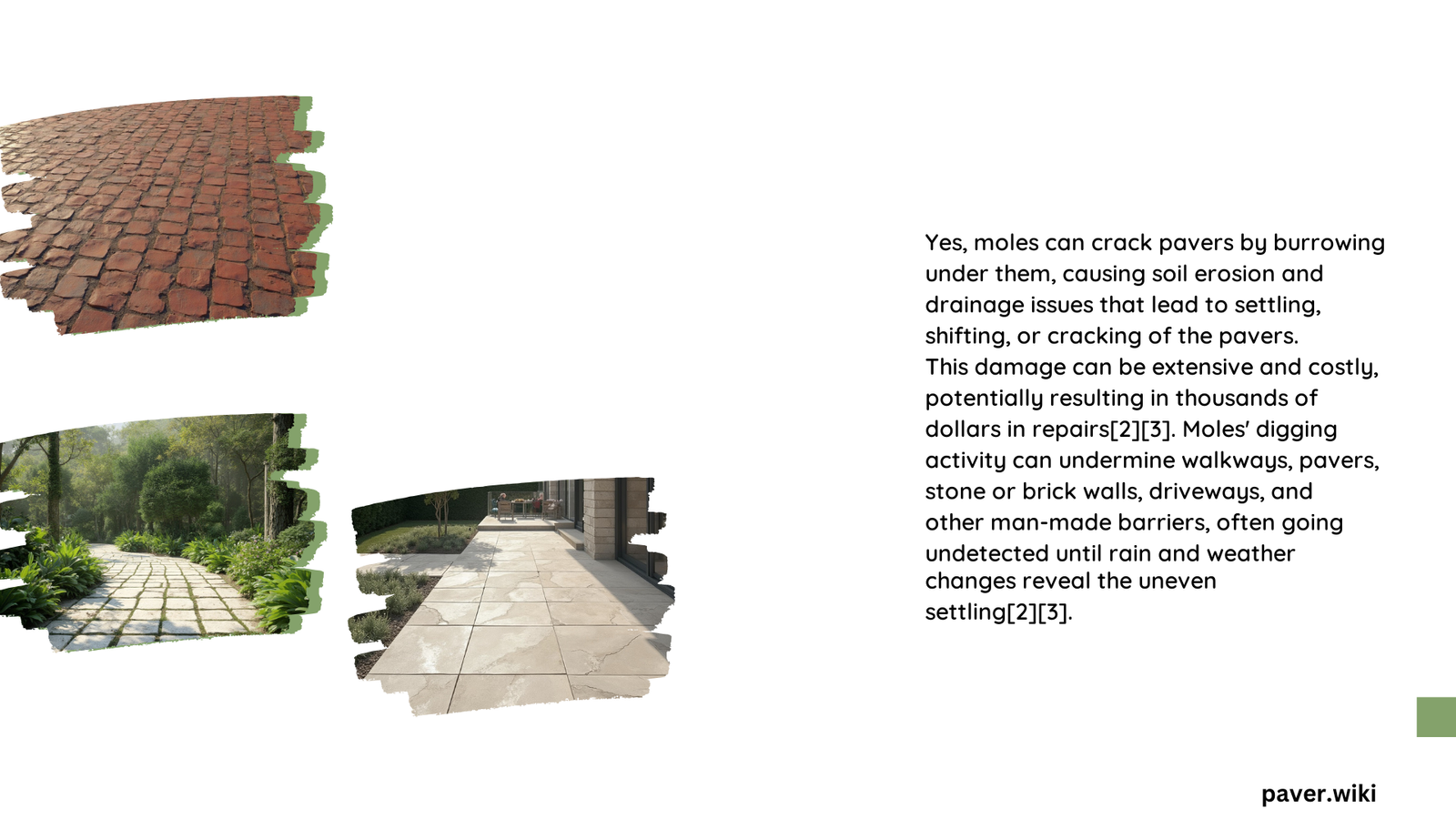Moles can indeed crack pavers through their burrowing activities. These small mammals create underground tunnels that can cause soil settlement, leading to uneven surfaces and cracks in paver installations. The damage can range from minor surface irregularities to significant structural issues, depending on the extent of mole activity and the type of pavers used. This article explores the relationship between mole activity and paver damage, signs to look out for, and effective prevention techniques.
How Do Moles Affect Paver Installations?
Moles are known for their extensive underground tunneling, which can have a significant impact on the stability of paver installations. Here’s how mole activity contributes to paver damage:
-
Soil Destabilization: Moles create complex tunnel systems that can extend several feet below the surface. These tunnels weaken the soil structure, leading to instability in the ground supporting the pavers.
-
Surface Settlement: As moles burrow, they displace soil, causing the ground above to settle. This settlement can result in uneven paver surfaces and potential cracking.
-
Void Creation: Abandoned mole tunnels can collapse over time, creating voids beneath the pavers. These voids can cause pavers to sink or crack under pressure.
-
Moisture Issues: Mole tunnels can alter the natural drainage patterns of the soil, potentially leading to water accumulation beneath pavers. This excess moisture can further destabilize the ground and contribute to paver damage.
What Are the Signs of Mole Damage to Pavers?

Identifying mole activity early can help prevent extensive damage to your paver installation. Look out for these telltale signs:
- Raised Soil Patterns: Visible ridges or raised lines in your lawn or garden beds near paver installations.
- Dirt Mounds: Small mounds of excavated soil, often referred to as “molehills,” appearing near paver edges.
- Uneven Paver Surfaces: Noticeable dips, rises, or misalignments in previously level paver areas.
- Cracks in Pavers: Visible cracks or splits in individual pavers, especially along edges or corners.
- Loose or Shifting Pavers: Pavers that feel unstable or move when walked upon.
Can Different Types of Pavers Resist Mole Damage?
While all types of pavers can be affected by mole activity, some may be more resistant than others:
| Paver Type | Resistance to Mole Damage | Reasons |
|---|---|---|
| Concrete Pavers | Moderate | Rigid structure, but can crack under pressure |
| Brick Pavers | Good | More flexible, can shift slightly without cracking |
| Natural Stone | Variable | Depends on stone type and installation method |
| Permeable Pavers | Poor to Moderate | Gaps between pavers may allow easier mole access |
It’s important to note that proper installation and a stable base are crucial factors in any paver’s resistance to mole damage.
How Can You Prevent Mole Damage to Pavers?
Protecting your paver installation from mole damage requires a multi-faceted approach:
- Install Underground Barriers:
- Use hardware cloth or metal mesh fencing buried at least 12-18 inches deep around the perimeter of your paver installation.
-
Extend the barrier a few inches above ground level to prevent moles from climbing over.
-
Use Deterrent Materials:
- Incorporate gravel or crushed stone into the soil beneath and around pavers.
-
These materials make it difficult for moles to tunnel and can discourage their activity.
-
Maintain Proper Drainage:
- Ensure your paver installation has adequate drainage to prevent water accumulation.
-
Moles are attracted to moist soil rich in earthworms and grubs.
-
Regular Inspection and Maintenance:
- Conduct periodic checks of your paver areas for signs of mole activity.
-
Fill any gaps or joints between pavers with polymeric sand to prevent mole entry.
-
Consider Professional Pest Control:
- If mole activity persists, consult with a professional pest control service for humane and effective mole management strategies.
What Are the Long-Term Effects of Mole Activity on Pavers?
Prolonged mole activity can have significant long-term consequences for paver installations:
- Reduced Lifespan: Continuous soil disturbance and settling can shorten the expected lifespan of your paver installation.
- Increased Maintenance Costs: Regular repairs and realignment of affected pavers may be necessary.
- Safety Hazards: Uneven or cracked pavers can pose tripping hazards for pedestrians.
- Aesthetic Degradation: Visible damage and irregularities can detract from the overall appearance of your hardscaping.
How Does Soil Type Influence Mole Damage to Pavers?
The type of soil beneath your pavers can significantly impact the extent of mole-related damage:
- Sandy Soil: More prone to collapse and settlement, potentially leading to more severe paver damage.
- Clay Soil: May resist tunneling to some extent but can experience dramatic shifts when mole activity does occur.
- Loamy Soil: Offers a balance but can still be susceptible to mole damage, especially when moist.
Understanding your soil type can help in developing targeted prevention strategies and choosing appropriate paver materials.
Are There Eco-Friendly Methods to Protect Pavers from Moles?
For those seeking environmentally conscious solutions, consider these eco-friendly approaches:
- Plant Natural Repellents:
- Castor bean plants, daffodils, and marigolds are known to deter moles.
-
Create a border of these plants around your paver installation.
-
Use Sound Deterrents:
-
Solar-powered sonic stakes emit vibrations that can discourage mole activity without harming the environment.
-
Encourage Natural Predators:
-
Create habitats for mole predators like owls and hawks by installing nesting boxes or perches near your property.
-
Organic Soil Treatments:
- Apply organic compounds like castor oil or garlic to the soil around pavers to repel moles naturally.
By implementing these eco-friendly methods, you can protect your pavers while maintaining a balanced ecosystem in your landscape.
In conclusion, while moles can indeed crack pavers, understanding their behavior and implementing preventive measures can significantly reduce the risk of damage. Regular monitoring, proper installation techniques, and a combination of deterrent methods can help maintain the integrity and appearance of your paver installations for years to come.
